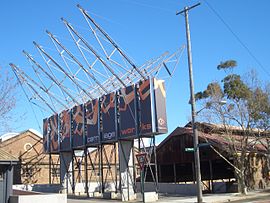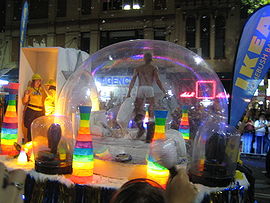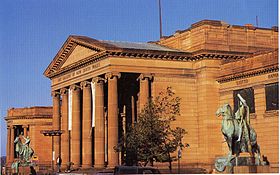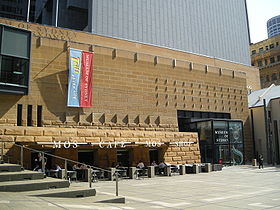- Culture of Sydney
-
The cultural life of Sydney, Australia is extremely dynamic, diverse and multicultural. Many of the individual cultures that make up the Sydney mosaic are centred on the cultural, artistic, ethnic, linguistic and religious communities formed by waves of immigration. (See History of Sydney.) Sydney is a major global city with a vibrant scene of musical, theatrical, visual, literary and other artistic activity. There is a longstanding friendly rivalry between Sydney and Melbourne for the title of 'Australia's arts capital'.
Contents
Music
The Sydney Symphony is internationally renowned and regularly performs in the Concert Hall (2,600 seats) of the Sydney Opera House under Chief Conductor Vladimir Ashkenazy. City Recital Hall is dedicated mainly to chamber music and chamber orchestra concerts, featuring many famous international artists as well as concert series by fine local groups such as the renowned Australian Chamber Orchestra and Sydney's foremost Baroque orchestra, the Australian Brandenburg Orchestra.
Opera Australia, the world's third-busiest opera company[citation needed], has its headquarters in Sydney and performs a busy program of mainly classical and occasionally contemporary operas at the Opera Theatre of the Sydney Opera House.
New experimental and avant-garde music is performed by Ensemble Offspring, Halcyon, The Noise and others, at the recently refurbished Carriageworks and many small inner-city cafes, warehouses, theatres etc. Both Liquid Architecture and What Is Music are annual festivals of modern music and sound art.
Jazz and alternative music (such as Sydney-based The Necks) are played at The Basement and Jazz at 72, and formerly at the now defunct Harbourside Brasserie. The Sound Lounge (SIMA), Jazzgroove, 505 and Red Rattler host regular jazz and alternative music events.
Many well-known Australian rock bands started up in Sydney, including Midnight Oil, The Easybeats, AC/DC, Rose Tattoo, The Vines and INXS, punk rock groups such as Radio Birdman and The Celibate Rifles, indie rockers The Clouds and The Crystal Set, to electronic music pioneers Severed Heads, Single Gun Theory, The Lab, Itch-E and Scratch-E and local favourites Sneaky Sound System. Other bands from the Sydney music scene are Angelspit and Wolfmother.
Sydney is famous for its alternative rock scene, and is the original home of the now national alternative rock festival the Big Day Out, which began in Sydney in 1992 featuring local bands such as You Am I and The Clouds and international groups like Nirvana.
Dance and ballet
The Sydney Dance Company under the leadership of Graeme Murphy has put on contemporary productions since the late 20th century. The Australian Ballet, whose headquarters are in Melbourne but which performs regularly in Sydney, is known and tours internationally[citation needed].
Performing arts
The Sydney Festival, held each year in January, is Sydney's and Australia's biggest performing arts festival, incorporating classical and contemporary music, theatre, visual arts, new media, etc. Many international and Australian performers appear.
The Sydney Theatre Company shows a regular roster of Australian (by authors such as noted playwright David Williamson), classic, and international plays. Their productions occasionally incorporate the return to the live stage of famous Australian screen actors such as Cate Blanchett, Hugo Weaving, Geoffrey Rush etc. The Wharf Theatre, the Sydney Theatre, the Drama Theatre of the Opera House and the Belvoir St Theatre (the home of Company B) are some of the main live theatre venues. The Bell Shakespeare Company, directed by John Bell, specializes in Shakespearean drama, with forays into modern plays such as Heiner Müller's 'Titus Andronicus'.
From the 1940s to the 1970s the Sydney Push, an intellectual subculture of authors and activists questioning of authority, including Germaine Greer, was active.
Sydney has several independent theatres for productions throughout the city centre including the Capitol Theatre (est. 1928, 2000 seats), the Lyric Theatre (2000 seats), the Theatre Royal (Est. 1827, 1200 seats) and the State Theatre (est. 1929, 2000 seats but stage not big enough for large productions).
The theatrical community has declined following the demolition of Her Majesty's and the Regent Theatres in the 1970s-80s, causing a the demand for more venues and appropriate stages for productions[citation needed].
Visual arts and museums
Sydney has been home to many visual artists, from the lush pastoralism of Lloyd Rees depictions of Sydney Harbour to Jeffrey Smart's portraits of bleak urban alienation, from the psychedelic visions of Brett Whiteley to a plethora of contemporary artists.
Sydney has a range of museums including those based on visual art such as the Museum of Contemporary Art, the Art Gallery of New South Wales, the White Rabbit Gallery, Artspace Sydney, the Brett Whiteley Studio; science and technology such as the Powerhouse Museum, Sydney Observatory, Sydney Tramway Museum, Australian National Maritime Museum and Australian Museum; and history such as the Museum of Sydney.
The Art Gallery of New South Wales (AGNSW), alongside major collections of Australian colonial and 20th century art and some works by European masters, has the largest and most important collection of Aboriginal art anywhere in the world. The Archibald Prize for portraiture (Australia's most prestigious art prize), the Sulman Prize for subject/genre painting and the Wynne Prize for landscape painting are awarded each year by the trustees of the AGNSW.
The Museum of Contemporary Art (MCA) at West Circular Quay is Australia's foremost contemporary art museum, featuring a mixture of exhibitions from the museum's permanent collection and visiting shows by major international artists. The White Rabbit Gallery is an exciting and releatively new museum dedicated solely to 21st century Chinese art. The Biennale of Sydney is an important festival dedicated to the contemporary visual arts, held bi-annually at the MCA and at various other venues around the city and often spilling into the streets. Another visual arts festival held at the MCA each spring is Primavera, a festival focusing on young, up-and-coming Australian artists.
A huge wrap-around mural by renowned American artist Sol LeWitt can be seen in the foyer of Australia Square Tower on the corner of George, Bond and Pitt Streets. Outside the tower, facing George Street, there is a large abstract steel sculpture by American sculptor Alexander Calder.
There are many commercial galleries focusing mainly on cutting-edge contemporary art all around the inner city suburbs of Woollahra, Newtown, Surry Hills, Paddington, Darlinghurst, Camperdown etc.
Graffiti and street art thrive in Sydney. The Newtown, Surry Hills and Glebe areas in particular have many innovative examples of murals and other street art.
A recent addition is Art Month Sydney, a month-long festival of the visual arts held throughout March.
Film
Sydney is Australia’s centre for commercial film and media. Many of the landmarks in Sydney have been referenced, shown and been the setting for countless films and television programs. Many films have been set in the city, including Finding Nemo, which was set in Port Jackson (Sydney Harbour). The city was used as downtown Angel Grove in 20th Century Fox's Mighty Morphin Power Rangers: The Movie (1995). The Matrix was also filmed in Sydney.
The international Sydney Film Festival takes place each year in June at various venues in the CBD.
Other film festivals in Sydney include the renowned short film festivals Tropfest and Flickerfest.
Literature and libraries
The Sydney Writers' Festival is held each year in May, featuring readings and discussions by Australian and international writers.
The largest library in Sydney is the State Library of New South Wales, which hold over 4.7 million items, including 2 million books.[1] Most local government areas within Sydney have local libraries including the City of Sydney Library with eight local branches, the Bankstown City Library,[2] the Max Webber Library in Blacktown and many others.
Children's entertainment
A large portion of Australia's children's entertainment originates in Sydney including highly successful musical groups The Wiggles and Hi-5 and television programs Play School, Bananas in Pyjamas, Saturday Disney, Skippy the Bush Kangaroo, Mr. Squiggle and many others.
Tourism, nightlife and festivals
A reported 21.1 million tourists visited Sydney in 2004. Many of the tourist attractions are scattered all over the city, the most famous and visited being the Sydney Opera House and the Sydney Harbour Bridge, which opened in 1932. Other attractions include the Royal Botanical Gardens, Luna Park and Sydney Tower.
Sydney has much night life, with jazz and rock venues and nightclubs across the city. Kings Cross is the city's red-light district. There are huge celebrations for New Years Eve and Australia Day in Sydney, including a fireworks display that features the Harbour Bridge.
Many festivals are held in Sydney, including the Sydney Festival, a celebration of free performances throughout January; the Gay and Lesbian Mardi Gras (see below); the Sydney Royal Easter Show, which unites rural and urban communities together in 1 annual event at Homebush; the Sydney Film Festival and many smaller festivals such as Tropfest.
There are also several music festivals including Big Day Out, Homebake and The Great Escape
Sport
Sport is an important part of the culture in Sydney. For more information go to Sport in Sydney and Sport in New South Wales.
Sydney communities and subcultures
Ethnic communities
Examples of ethnic communities in Sydney include;
Suburb Community Notes Ashfield Chinese Particularly Shanghainese: this suburb is known in the wider Chinese community as Little Shanghai[3] Auburn Turkish/Hazaras Bankstown Lebanese/Vietnamese Blacktown Filipino Also in the greater Blacktown area Brighton-Le-Sands Greek Bondi Irish/Scottish/English/Jewish Cabramatta Vietnamese, and Khmer, Han Chinese, Thais, Lao Predominately Vietnamese Campsie Chinese/Korean Chatswood Hong Kong Chinese Dee Why Tibetan Earlwood Greek Eastwood Korean/Mainland Chinese Cantonese and Mandarin Chinese dialects. Fairfield Assyrian, Bosnians, Vietnamese, Italian and Hispanic Greystanes Maltese/Yugoslavs Homebush Sri Lankan/South Indian Hurstville Chinese Kingsford Indonesia) Leichhardt Italian Liverpool Bosnians Manly Irish/Scottish/English/Danish/Norwegian/Swedish Maroubra French Mount Kuring-gai Polish Northbridge Japanese Petersham Portuguese St Ives South African/Jewish Strathfield Shanghainese/Korean Waverley Russians Willoughby Armenian These are only general representations of the distribution of ethnic groups in Sydney. So, for example, while there are many people of Asian culture in Eastwood, the majority of the population is still of a European background. Areas with a large proportion of people born overseas and with non-English speaking backgrounds include Auburn, Fairfield, Liverpool, and Bankstown. Generally Western European and North American born people have settled around the Lower North Shore and eastern suburbs, Middle Eastern people around the Lakemba-Auburn region, Indo-Chinese in the south-western suburbs, South Asians around Parramatta and the south east, and North East Asians in major nodes such as Hurstville, Burwood, Strathfield, Chatswood, Eastwood, Campsie and Haymarket.
Apart from English, the 31 most widely-spoken languages in Sydney are: (2004)[citation needed]
- Arabic
- Cantonese
- Greek
- Italian
- Vietnamese
- Mandarin
- Spanish
- Tagalog
- Korean
- Hindi
- Bosnian
- Croatian
- Macedonian
- Serbian
- Turkish
- Indonesian
- Maltese
- German
- Polish
- Assyrian
- Russian
- French
- Persian
- Tamil
- Portuguese
- Samoan
- Thai
- Japanese
- Khmer
- Hungarian
- Armenian
- Bengali
All languages above have over 5000 speakers in the city; Arabic and Cantonese both have over 150,000 speakers.
The gay & lesbian community
Sydney has a significant gay community, centred on Oxford Street, and holds the annual Sydney Gay and Lesbian Mardi Gras.
The Sydney lesbian community, though still active around Oxford street, is well established and visible in Newtown and Enmore in Sydney's inner west. There is also a history of lesbian community congregating in Leichhardt, and other inner west suburbs. Sydney does not have a full-time lesbian bar; lesbian night-life centres around regular nights such as Velvet Wednesdays at The Bank Hotel, Queer Central, Wednesdays at the Sly Fox - both in Newtown. Popular monthly women's nights include The Pussycat Club, Saturdays at The Supper Club, Lemons with a Twist at Slide Nightclub and Moist at Arq. There are also suburban lesbian nights at local pubs around Sydney. The Red Rattler Theatre in Marrickville is a popular venue for queer events, performance nights, burlesque and private parties.
There are two magazines available in Sydney and one website with detailed information on Sydney's lesbian community and night-life. LOTL and Cherry magazines are free, monthly, Australia wide, publications which can be found around Oxford Street, Glebe and Newtown. The Sapphic Sydney website is a relatively new resource which details events and community groups as well as featuring a local business directory.
There is also a thriving indie queer publishing community in Sydney publishing magazines such as Slit magazine, Dirty Queer magazine and Spunk magazine.
References
Sapphic Sydney - The Lesbian Guide to Sydney
History · Geography · Demographics · Economy · Transportation ·Culture · Architecture · Tourism · EducationMusic of Australia Genres Organisations Awards Charts Festivals Media Channel V Australia · CMC · Community Radio · Countdown · Max · MTV · Rage · Triple J · triple j tv · Video Hits · VH1 · Rolling Stone Australia · Go-SetNational anthem Cities and regions See also: Timeline · Portal Categories:- Sydney culture
Wikimedia Foundation. 2010.








